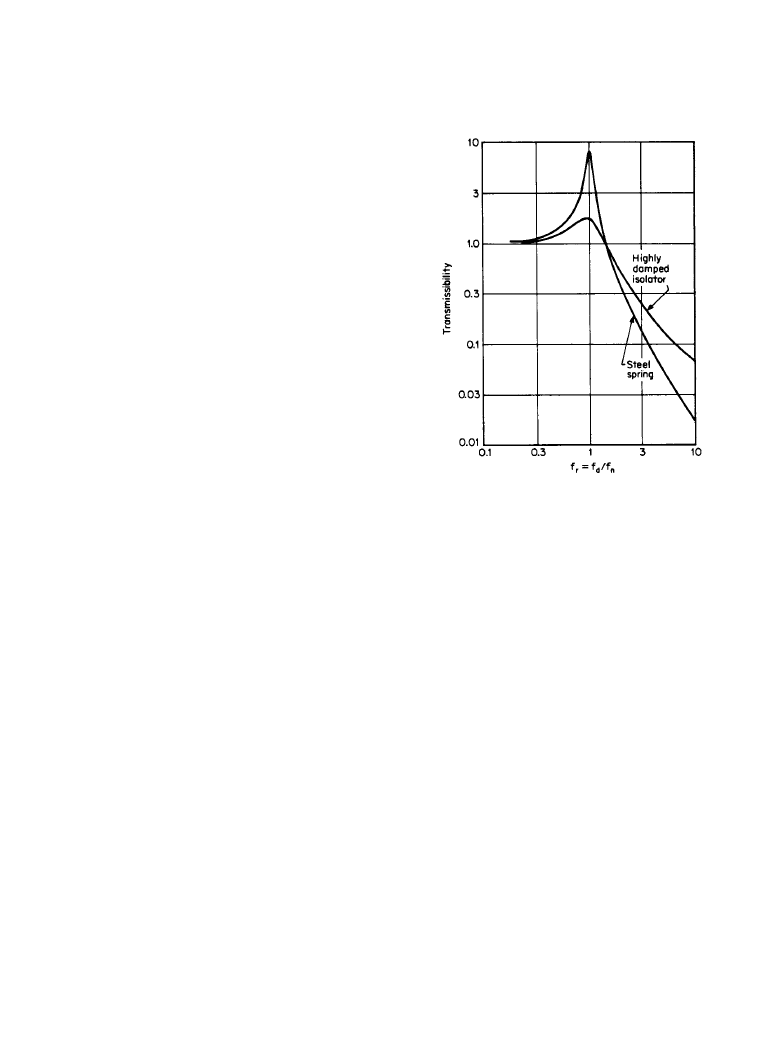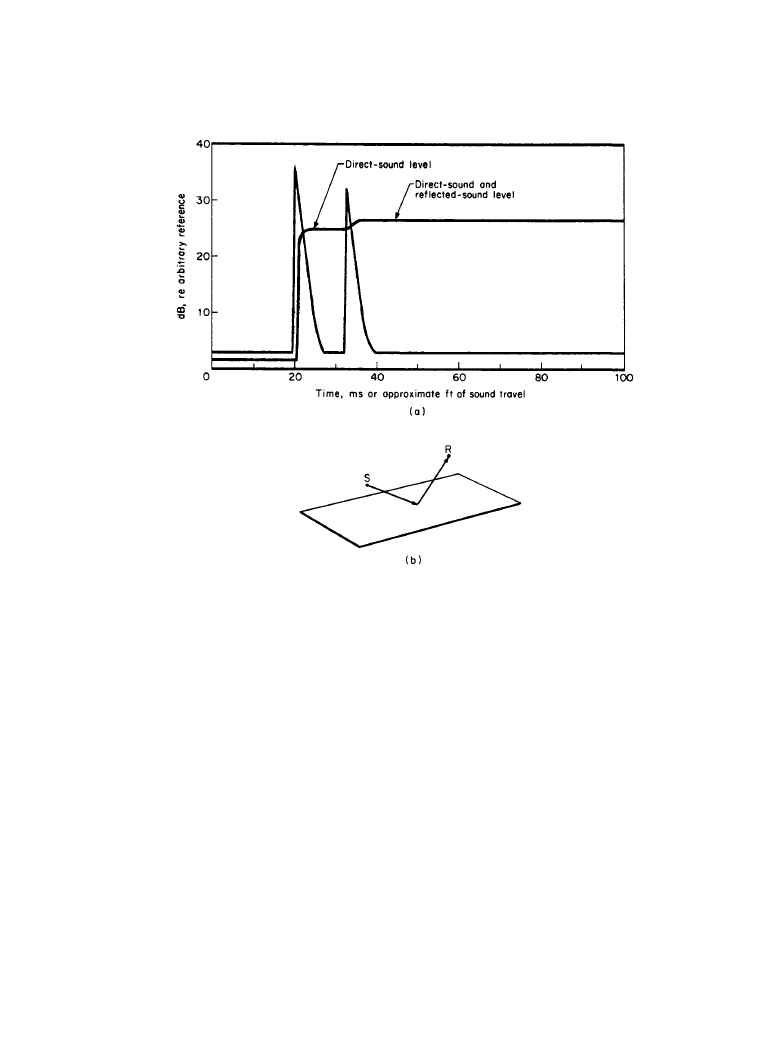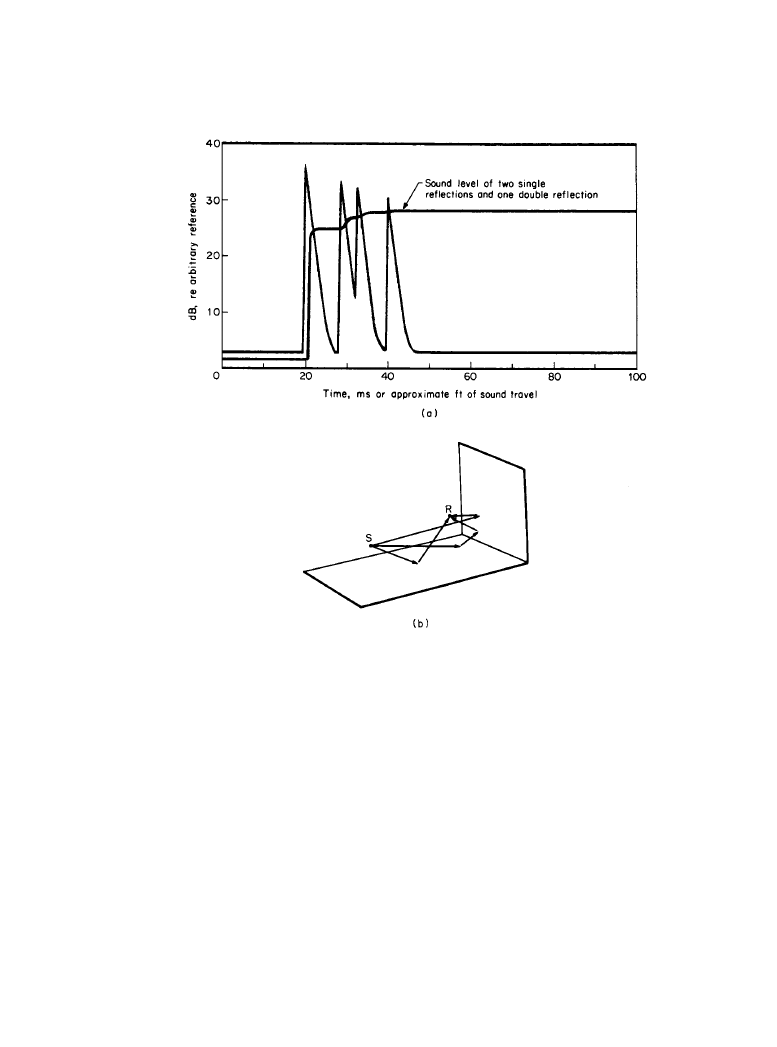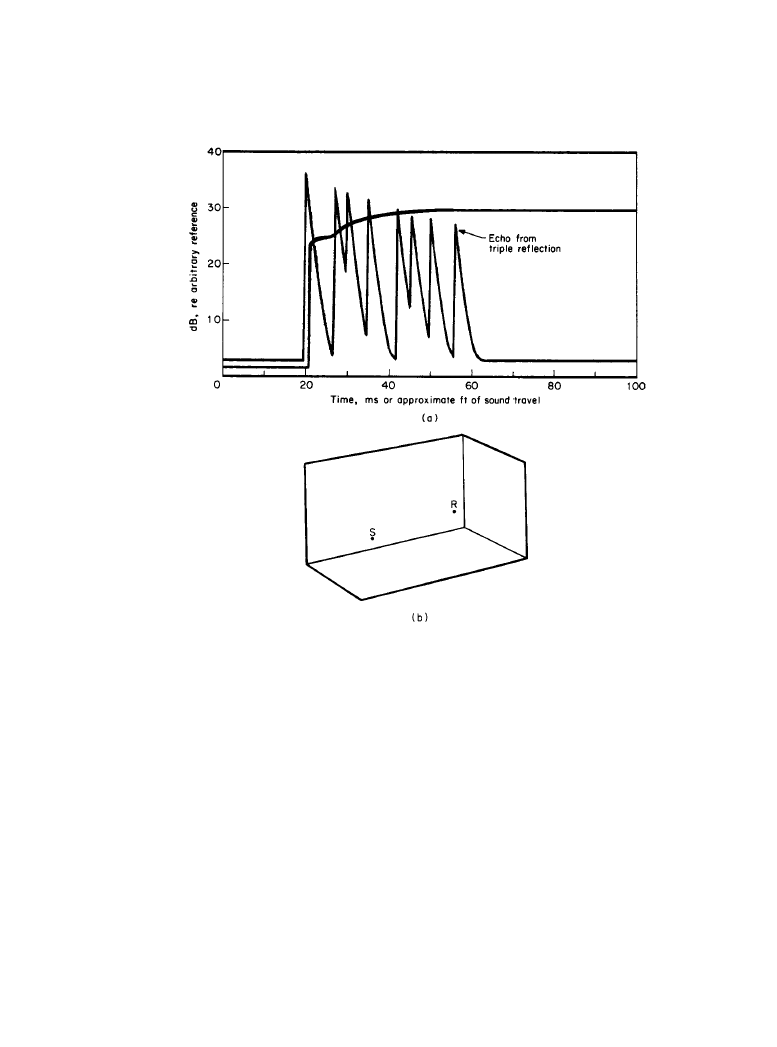ВУЗ: Казахская Национальная Академия Искусств им. Т. Жургенова
Категория: Книга
Дисциплина: Не указана
Добавлен: 03.02.2019
Просмотров: 21626
Скачиваний: 19

3-40 Architectural Acoustic Principles and Design Techniques
where d is deflection, mm.
3.3.3b
Vibration Transmission
Transmissibility rates the effectiveness of the vibration isolation system. Figure 3.3.3 shows a
plot of transmissibility against frequency ratio for a steel spring and a highly damped isolator.
Steel springs are used where the driving frequency is below 30 Hz. Neoprene is used for higher
driving frequencies.
The vibration isolation system is selected according to the static deflection necessary to pro-
vide adequate transmissibility. The procedure is as follows:
•
Select the material of construction of the mounts for transmissibility according to the applica-
tion. A transmissibility of 0.03 is generally acceptable. Also, if the equipment to be isolated is
to be located in close proximity to a critical space, special designs should be considered.
•
Find the value of f
r
, the ratio of driving frequency to the natural frequency, which intersects
the transmissibility curve at the proper value of transmissibility. For example, in Figure 3.3.3,
which shows the transmissibility curve of a steel spring, a minimum value of 8 for f
r
is neces-
sary to achieve a transmissibility of 0.03.
•
Determine the static deflection from Equation (3.3.2).
•
Select from a manufacturer’s catalog mounts of the required material of a size that will deflect
the calculated amount under the static load of the machine.
Figure 3.3.3
Transmissibility of a steel spring and
a highly damped isolator.
Downloaded from Digital Engineering Library @ McGraw-Hill (www.digitalengineeringlibrary.com)
Copyright © 2004 The McGraw-Hill Companies. All rights reserved.
Any use is subject to the Terms of Use as given at the website.
Sound Isolation

Sound Isolation 3-41
3.3.3c
Vibration Isolation
It is important to note that several factors can significantly reduce the effectiveness of isolators.
Any item that short-circuits the isolator, such as rigid conduit or solid refuse lodged under the
equipment, can carry substantial vibrations to the building structure and seriously degrade the
performance of an isolation system. In addition, if the isolators stand on a flexible floor span
rather than a basement slab, reduced isolation must be expected. In this special situation more
sophisticated methods than those outlined here must be used to ensure adequate performance [1].
3.3.4
Interior Acoustics
Previous sections have primarily addressed issues relating to the amplitude of sound, or sound
pressure level. Here the quality of sound is considered with primary emphasis on the natural
acoustics of an interior space.
Interior acoustics are graphically illustrated here with actual displays from an acoustical scale
model in which wall components are progressively assembled to form a complete room. The
noise source is a small electric spark that produces a short impulsive sound, and the listener is
represented by a special high-frequency microphone. For each model configuration an echogram
is made in which the vertical scale is in decibels and the horizontal scale is in milliseconds, with
zero time being the instant when the sound is generated at its source. Though a 1:20-scale model
was used, all illustrations are indicated for full scale. Similar echo-grams may be made in a
building by using a bursting balloon as a sound source, but, of course, it is not as easy to change
the room shape rapidly.
When source and microphone are located above a very reflective floor with the angles of inci-
dence and reflection at 45º, the echogram can be seen as the spiky trace shown by the solid line
in Figure 3.3.4. The floor echo arrives 10 ms alter the direct sound, traveling 2 times farther and
also spreading 6 dB per doubling of the distance. With the two impulses arriving at less than 50
ms apart, the ear is unable to resolve the sound into two separate sounds, just hearing one. The
second trace, a steplike waveform in the same figure, is calculated in the signal analyzer and is a
summation of all the sound energy in arriving echoes. At any point of time it shows the total
sound energy that has been received up to that moment. This display is the equivalent steady-
state sound level of the impulsive sound. It can be seen from this line that the reflection adds only
a step of 2 dB to the level of the direct sound. Subjectively, the echo makes the direct sound seem
only just a little louder, for the ear cannot easily detect a 2-dB increase in sound level.
With the erection of a single wall, another impulse appears on the echogram, the reflection
from the wall. But Figure 3.3.5 shows that there is yet another echo, one that is the result of the
sound traveling in sequence from floor to wall. The three echoes are not equal in strength to the
direct sound. Instead, since they are attenuated by spherical spreading, they add merely 4 dB to
the direct sound.
One wall may be added to the first wall at right angles as shown in Figure 3.3.6. Now it
becomes more complicated to calculate the number of echoes that will appear. In fact, eight
spikes are now shown. They can be traced to reveal the direct sound, three single reflections,
three double reflections, and one triple reflection. From the steplike trace it can be seen that they
add 6 dB to the direct-sound level. An increase in level of this magnitude is readily detected by
the ear.
Downloaded from Digital Engineering Library @ McGraw-Hill (www.digitalengineeringlibrary.com)
Copyright © 2004 The McGraw-Hill Companies. All rights reserved.
Any use is subject to the Terms of Use as given at the website.
Sound Isolation

3-42 Architectural Acoustic Principles and Design Techniques
As can be seen from the echogram in Figure 3.3.6, this initial package of sound echoes typi-
cally constitutes the bulk of the sound energy that arrives at the listener in a completed room. The
initial echo structure is important in the way in which the listener perceives the sound. If this
package of early arrivals is no more that 50 ms wide, it will be perceived by the listener as being
the direct sound. If it is stretched out, the music will lose precision and definition. In smaller,
narrower halls, the sidewalls provide early reflections, but in a large fan-shaped hall lateral
reflections from walls arrive too late to help. Likewise the ceiling often cannot contribute
because it is too far away. Thus to provide these early reflections, “clouds” are often hung above
the stage and angled for sound dispersion.
Alternatively a parallel wall may be added as shown in Figure 3.3.7. This gives an echogram
reminiscent of sneaking a sideways view between parallel mirrors. The images extend with
decreasing strength to infinity. They are not evenly spaced but paired because the sound travels
farther in its reflection from one wall than the other. This echogram depicts the phenomenon
known as flutter, in which sound most unpleasantly zings between parallel walls. Care must be
taken in room design to prevent flutter between windows and the opposite wall or between a hard
ceiling and floor. One of the pair of reflective surfaces must be made absorptive or be angled to
diffuse the sound.
Figure 3.3.4
Echogram of sound reflecting from a hard surface.
Downloaded from Digital Engineering Library @ McGraw-Hill (www.digitalengineeringlibrary.com)
Copyright © 2004 The McGraw-Hill Companies. All rights reserved.
Any use is subject to the Terms of Use as given at the website.
Sound Isolation

Sound Isolation 3-43
With the first wall replaced so that three walls are now standing, the configuration in Figure
3.3.8 is similar to a complete room with an acoustically dead end, a live end, and a dead ceiling.
The previous clear infinite string of images is now concealed among many other echoes, making
it almost impossible to identify the path of each, particularly as many echoes overlap each other.
The echogram is reminiscent of a reverberation decay curve. However, its unevenness reinforces
the concern that reverberation-time measurements within such a room can lead to erroneous
results.
As the remaining wall and ceiling are added, the echogram becomes more continuous until it
is filled in with echoes. Figure 3.3.9 shows the fully reverberant echogram of the complete space.
The reverberation time is 3 s. Note that the final sound level is 34 dB. This sound level is reached
substantially in just 10 percent of the reverberation time.
It is important that the later-arriving echoes do not “muddy” or mask the earlier sound. Thus,
to maintain good sound definition for music, the sound energy arriving after the first 50 ms
should increase the level by approximately 3 dB. In Figure 3.3.9 note that the sound level
Figure 3.3.5
Echogram of sound reflecting from one wall and a floor.
Downloaded from Digital Engineering Library @ McGraw-Hill (www.digitalengineeringlibrary.com)
Copyright © 2004 The McGraw-Hill Companies. All rights reserved.
Any use is subject to the Terms of Use as given at the website.
Sound Isolation

3-44 Architectural Acoustic Principles and Design Techniques
increases by 7 dB after the early arrivals, showing too much reverberation for music. For clear
speech, the increase should be approximately 1 to 2 dB above the earlier sound energy. A more
in-depth treatment of preferred relationships between early- and late-arriving sound energy can
be found in [2 and 3].
It is most desirable to have the echoes decaying with gradually decreasing amplitude. A dis-
crete echo can be caused by focusing, as when sound reflects from a curved wall in the rear of a
fan-shaped room. For some listeners the focused sound may arrive well after the early arrivals
and be clearly identifiable. For a rear wall, this effect is usually controlled by absorbing the
sound at the curved wall. However, the sound may be diffused by installing angled reflecting sur-
faces which each have dimensions greater than the wavelength of the sound. The placement and
angles will need careful determination so that other focusing is not formed.
Figure 3.3.6
Echogram of sound reflecting from a floor and two walls at right angles.
Downloaded from Digital Engineering Library @ McGraw-Hill (www.digitalengineeringlibrary.com)
Copyright © 2004 The McGraw-Hill Companies. All rights reserved.
Any use is subject to the Terms of Use as given at the website.
Sound Isolation